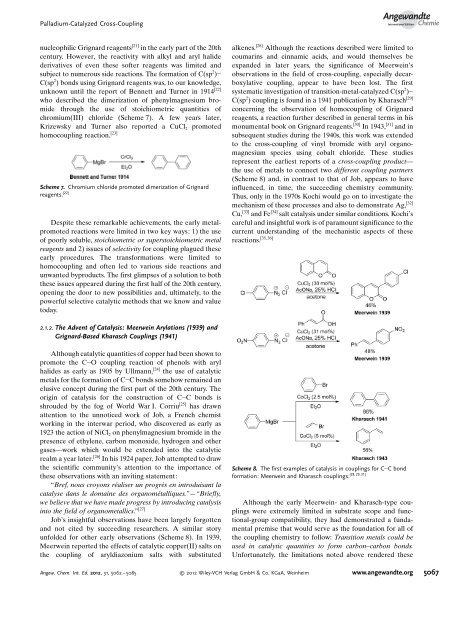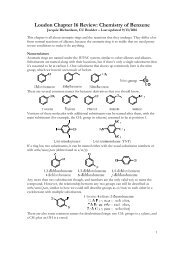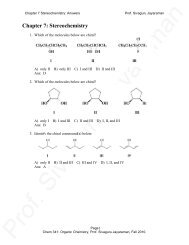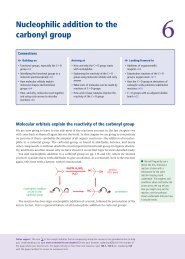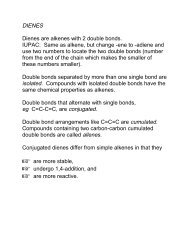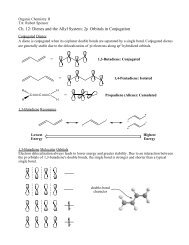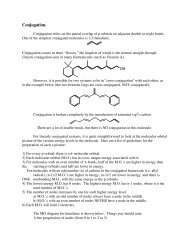Palladium-Catalyzed Cross-Coupling - A Historical Contextual Perspective to the 2010 Nobel Prize
Palladium-Catalyzed Cross-Coupling - A Historical Contextual Perspective to the 2010 Nobel Prize
Palladium-Catalyzed Cross-Coupling - A Historical Contextual Perspective to the 2010 Nobel Prize
Create successful ePaper yourself
Turn your PDF publications into a flip-book with our unique Google optimized e-Paper software.
<strong>Palladium</strong>-<strong>Catalyzed</strong> <strong>Cross</strong>-<strong>Coupling</strong>AngewandteChemienucleophilic Grignard reagents [21] in <strong>the</strong> early part of <strong>the</strong> 20thcentury. However, <strong>the</strong> reactivity with alkyl and aryl halidederivatives of even <strong>the</strong>se softer reagents was limited andsubject <strong>to</strong> numerous side reactions. The formation of C(sp 2 )C(sp 2 ) bonds using Grignard reagents was, <strong>to</strong> our knowledge,unknown until <strong>the</strong> report of Bennett and Turner in 1914 [22]who described <strong>the</strong> dimerization of phenylmagnesium bromidethrough <strong>the</strong> use of s<strong>to</strong>ichiometric quantities ofchromium(III) chloride (Scheme 7). A few years later,Krizewsky and Turner also reported a CuCl 2 promotedhomocoupling reaction. [23]Scheme 7. Chromium chloride promoted dimerization of Grignardreagents. [22]Despite <strong>the</strong>se remarkable achievements, <strong>the</strong> early metalpromotedreactions were limited in two key ways: 1) <strong>the</strong> useof poorly soluble, s<strong>to</strong>ichiometric or supers<strong>to</strong>ichiometric metalreagents and 2) issues of selectivity for coupling plagued <strong>the</strong>seearly procedures. The transformations were limited <strong>to</strong>homocoupling and often led <strong>to</strong> various side reactions andunwanted byproducts. The first glimpses of a solution <strong>to</strong> both<strong>the</strong>se issues appeared during <strong>the</strong> first half of <strong>the</strong> 20th century,opening <strong>the</strong> door <strong>to</strong> new possibilities and, ultimately, <strong>to</strong> <strong>the</strong>powerful selective catalytic methods that we know and value<strong>to</strong>day.alkenes. [28] Although <strong>the</strong> reactions described were limited <strong>to</strong>coumarins and cinnamic acids, and would <strong>the</strong>mselves beexpanded in later years, <strong>the</strong> significance of Meerweinsobservations in <strong>the</strong> field of cross-coupling, especially decarboxylativecoupling, appear <strong>to</strong> have been lost. The firstsystematic investigation of transition-metal-catalyzed C(sp 2 )C(sp 2 ) coupling is found in a 1941 publication by Kharasch [29]concerning <strong>the</strong> observation of homocoupling of Grignardreagents, a reaction fur<strong>the</strong>r described in general terms in hismonumental book on Grignard reagents. [30] In 1943, [31] and insubsequent studies during <strong>the</strong> 1940s, this work was extended<strong>to</strong> <strong>the</strong> cross-coupling of vinyl bromide with aryl organomagnesiumspecies using cobalt chloride. These studiesrepresent <strong>the</strong> earliest reports of a cross-coupling product—<strong>the</strong> use of metals <strong>to</strong> connect two different coupling partners(Scheme 8) and, in contrast <strong>to</strong> that of Job, appears <strong>to</strong> haveinfluenced, in time, <strong>the</strong> succeeding chemistry community.Thus, only in <strong>the</strong> 1970s Kochi would go on <strong>to</strong> investigate <strong>the</strong>mechanism of <strong>the</strong>se processes and also <strong>to</strong> demonstrate Ag, [32]Cu, [33] and Fe [34] salt catalysis under similar conditions. Kochiscareful and insightful work is of paramount significance <strong>to</strong> <strong>the</strong>current understanding of <strong>the</strong> mechanistic aspects of <strong>the</strong>sereactions. [35,36]2.1.2. The Advent of Catalysis: Meerwein Arylations (1939) andGrignard-Based Kharasch <strong>Coupling</strong>s (1941)Although catalytic quantities of copper had been shown <strong>to</strong>promote <strong>the</strong> C O coupling reaction of phenols with arylhalides as early as 1905 by Ullmann, [24] <strong>the</strong> use of catalyticmetals for <strong>the</strong> formation of C C bonds somehow remained anelusive concept during <strong>the</strong> first part of <strong>the</strong> 20th century. Theorigin of catalysis for <strong>the</strong> construction of C C bonds isshrouded by <strong>the</strong> fog of World War I. Corriu [25] has drawnattention <strong>to</strong> <strong>the</strong> unnoticed work of Job, a French chemistworking in <strong>the</strong> interwar period, who discovered as early as1923 <strong>the</strong> action of NiCl 2 on phenylmagnesium bromide in <strong>the</strong>presence of ethylene, carbon monoxide, hydrogen and o<strong>the</strong>rgases—work which would be extended in<strong>to</strong> <strong>the</strong> catalyticrealm a year later. [26] In his 1924 paper, Job attempted <strong>to</strong> draw<strong>the</strong> scientific communitys attention <strong>to</strong> <strong>the</strong> importance of<strong>the</strong>se observations with an inviting statement:“Bref, nous croyons rØaliser un progr›s en introduisant lacatalyse dans le domaine des organomØtalliques.”—“Briefly,we believe that we have made progress by introducing catalysisin<strong>to</strong> <strong>the</strong> field of organometallics.” [27]Jobs insightful observations have been largely forgottenand not cited by succeeding researchers. A similar s<strong>to</strong>ryunfolded for o<strong>the</strong>r early observations (Scheme 8). In 1939,Meerwein reported <strong>the</strong> effects of catalytic copper(II) salts on<strong>the</strong> coupling of aryldiazonium salts with substitutedScheme 8. The first examples of catalysis in couplings for C C bond[28, 29, 31]formation: Meerwein and Kharasch couplings.Although <strong>the</strong> early Meerwein- and Kharasch-type couplingswere extremely limited in substrate scope and functional-groupcompatibility, <strong>the</strong>y had demonstrated a fundamentalpremise that would serve as <strong>the</strong> foundation for all of<strong>the</strong> coupling chemistry <strong>to</strong> follow: Transition metals could beused in catalytic quantities <strong>to</strong> form carbon–carbon bonds.Unfortunately, <strong>the</strong> limitations noted above rendered <strong>the</strong>seAngew. Chem. Int. Ed. 2012, 51, 5062 – 5085 2012 Wiley-VCH Verlag GmbH & Co. KGaA, Weinheim www.angewandte.org5067


